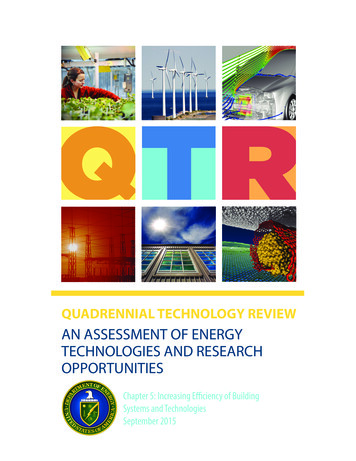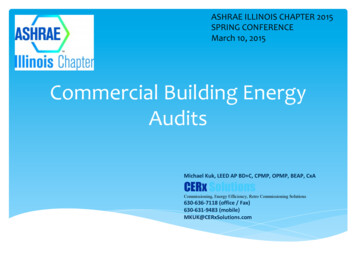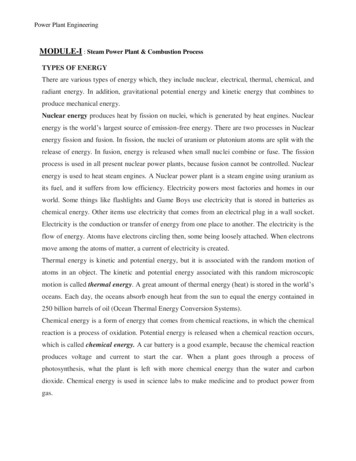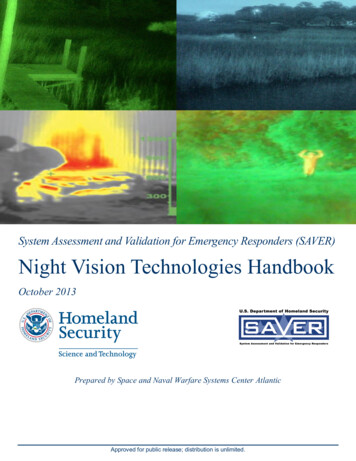
Transcription
QUADRENNIAL TECHNOLOGY REVIEWAN ASSESSMENT OF ENERGYTECHNOLOGIES AND RESEARCHOPPORTUNITIESChapter 5: Increasing Efficiency of BuildingSystems and TechnologiesSeptember 2015
5Increasing Efficiency of Building Systems and TechnologiesIssues and RDD&D OpportunitiesThe buildings sector accounts for about 76% of electricity use and 40% of all U. S.primary energy use and associated greenhouse gas (GHG) emissions, making itessential to reduce energy consumption in buildings in order to meet national energyand environmental challenges (Chapter 1) and to reduce costs to building ownersand tenants. Opportunities for improved efficiency are enormous. By 2030, buildingenergy use could be cut more than 20% using technologies known to be cost effectivetoday and by more than 35% if research goals are met. Much higher savings aretechnically possible.Building efficiency must be considered as improving the performance of a complexsystem designed to provide occupants with a comfortable, safe, and attractive livingand work environment. This requires superior architecture and engineering designs,quality construction practices, and intelligent operation of the structures. Increasingly,operations will include integration with sophisticated electric utility grids.The major areas of energy consumption in buildings are heating, ventilation, andair conditioning—35% of total building energy; lighting—11%; major appliances(water heating, refrigerators and freezers, dryers)—18% with the remaining 36% inmiscellaneous areas including electronics. In each case there are opportunities bothfor improving the performance of system components (e.g., improving the efficiencyof lighting devices) and improving the way they are controlled as a part of integratedbuilding systems (e.g., sensors that adjust light levels to occupancy and daylight).Key research opportunities include the following: Thin insulating materials Windows and building surfaces with tunable optical properties Quadrennial Technology ReviewHigh-efficiency heat pumps that reduce or eliminate the use of refrigerants thatcan lead to GHG emissionsHigh efficiency lighting devices including improved green light-emitting diodes,phosphors, and quantum dots Improved software for optimizing building design and operation Low cost, easy to install, energy harvesting sensors and controls Interoperable building communication systems and optimized control strategies Decision science issues affecting purchasing and operating choices
5Increasing Efficiency of Building Systemsand Technologies5.1 IntroductionMore than 76% of all U.S. electricity use and more than 40% of all U.S. energy use and associated greenhousegas (GHG) emissions are used to provide comfortable, well-lit, residential and commercial buildings—andto provide space conditioning and lighting for industrial buildings. Successfully meeting priority technologygoals for performance and cost will make it possible to significantly reduce this energy use by 2030 in spite offorecasted growth in population and business activity.Figure 5.1 shows U.S. building energy use in 2014.1 Space conditioning, water heating, and lighting represent wellover half of the total, including energy used in outdoor lighting and cooling most data centers.Figure 5.1 Buildings Use More Than 38% of all U.S. Energy and 76% of U.S. Electricity12014 Residential and CommercialBuilding Primary Energy Use (Quads)2014 Electricity Sale for dential37%Commercial35%Lighting4.35Water mputers andElectronics2.35Total primary energy use in buildings 38.5 QuadsIndustrial HVACand Lighting3%Other Industrial24%Key: Quad quadrillion Btu; Btu British thermal unitThe building sector’s share of electricity use has grown dramatically in the past five decades from 25% of U.S.annual electricity consumption in the 1950s to 40% in the early 1970s to more than 76% by 2012.2 Absentsignificant increases in building efficiency, total U.S. electricity demand would have grown much more rapidlythan it did during this period.5
5Increasing Efficiency of Building Systems and TechnologiesFigure 5.2 Use of ENERGY STAR technologies would reduce residential energy consumption 30%, best available technology 50%, goalsof ET 52% and theoretical limits 62%. No savings are assumed for“other” technologies that become the dominant energy use in highsavings scenarios. (EUI)Figure 5.3 Use of ENERGY STAR technologies would reduce commercial energy consumption 21%, best available technology 46%, goalsof ET 47% and theoretical limits 59%. No savings are assumed for“other” technologies that become the dominant energy use in highsavings scenarios. (EUI)Figure 5.2 and Figure 5.3 compare residential and commercial energy use in the current building stock withbuildings using ENERGY STAR equipment, today’s best available technologies, technologies meeting DOE’semerging technologies (ET 2020) cost and performance goals, and the energy used if all equipment operated attheoretical efficiency limits (e.g., perfect heat pumps). In most cases, the best available technologies have similarperformance to those meeting the ET 2020 goals, but planned research advances will make those technologiescost-effective by 2020.The cost goals represent the DOE’s analysis of material costs and manufacturing methods judged plausible,including expert solicitations shown in the cited roadmaps.3 Some of these goals are shown in Table 5.14 (seealso the supplemental information on roadmaps for this chapter on the web).Considering only cost-based analysis of new energy efficiency technologies has limitations. For example,features such as improving the ability to comfortably stand by a window on a cold day or changing the colorof lighting reflect qualitative values that may affect consumer preferences but would be difficult to analyzequantitatively. None of the economic analysis presented here reflects the social cost of carbon, and none of themreflects services that could be provided to the electric grid (see Chapter 3). Furthermore, the savings shown inthe ENERGY STAR scenario in Figure 5.2 and Figure 5.3 include measures that are cost-effective today but arenot being used because of a complex set of market failures.Capturing the much larger, potential future savings, reflected in the best available ET 2020 and thermodynamiclimit scenarios, requires a well-designed research, development, demonstration, and deployment (RDD&D)program, the focus of this chapter. It will also require market-focused programs that encourage rapidadoption of efficient technologies including credible information, standards, labels, and other policies thathelp consumers understand the costs and benefits of energy-purchasing decisions, and programs to ensure anadequate supply of workers with the skills needed to design, build, and operate new energy systems.The figures show no reduction in energy used for “other” uses, which include televisions and computermonitors, computers, other electronics, and miscellaneous devices. This is not because their efficiency can’tbe improved but because the total is the sum of a very large number of different devices. In many cases,146Quadrennial Technology Review
commercial investment in theTable 5.1 Sample ET Program 2020 Goalstechnology is driving changeso fast that federal appliedresearch will have limited value.Current2020 goalRapidly increasing demand forInsulationR-6/in and 1.1/ft2R-8/in and 0.35/ft2fast information processing,for example, is facing energyWindows (residential)R-5.9/in and 63/ft2R-10/in and 10/ft2use limits, which are drivingVapor-compression2.0 Primary COPan enormous amount of1.84 COP and 68.5 /heating, ventilation, andand 23/kBtu/hr costkBtu/hr cost premiumprivate research investment.air conditioning (HVAC)premiumIt is important to determine2.3 Primary COPwhere and how to productivelyNon-vaporNot on marketand 20/kBtu/hr costcompression HVACinvest in RDD&D that couldpremiumimprove the efficiency of231 lm/W andan electronic componentLEDs (cool white)166 lm/W and 4/klm 0.7/klmused by these products, anddepending on research results,16% reduction in35% reduction inDaylighting and controls2private research efforts andlighting for 4/ftlighting for 13/ft2competing priorities withinHeat pump50% savings andbudget limitations, the mixNot on marketclothes dryers 570 cost premiumof appropriate investments islikely to change over time. Asan example, the development and application of wide band gap semiconductors could reduce energy use ina number of miscellaneous devices but currently has insufficient RDD&D investment to drive this forwardin a timely manner. Excluding this “other” category, Figures 5.2 and 5.3 show that building energy use can bereduced by about half.5Buildings last for decades (consider that more than half of all commercial buildings in operation today werebuilt before 1970),5 so it’s important to consider technologies that can be used to retrofit existing buildingsas well as new buildings. Many of the technologies assumed in Figure 5.2 and Figure 5.3 can be used in bothnew and existing structures (e.g., light-emitting diodes [LEDs]). Retrofits present unique challenges, andtechnologies focused on retrofits merit attention because of the large, existing stock and its generally lowerefficiency. These include low-cost solutions such as thin, easily-installed insulation, leak detectors, devices todetect equipment and systems problems (e.g., air conditioners low on refrigerants), and better ways to collectand disseminate best practices.Energy use in buildings depends on a combination of good architecture and energy systems design andon effective operations and maintenance once the building is occupied. Buildings should be treated assophisticated, integrated, interrelated systems. It should also be understood that different climates probablyrequire different designs and equipment, and that the performance and value of any component technologydepends on the system in which it is embedded. Attractive lighting depends on the performance of the devicesthat convert electricity to visible light, as well as on window design, window and window covering controls,occupancy detectors, and other lighting controls. As the light fixture efficiency is greatly increased, lightingcontrols will have a reduced net impact on energy use. In addition, the thermal energy released into the roomby lighting would decrease, which then affects building heating and cooling loads.Since buildings consume a large fraction of the output of electric utilities, they can greatly impact utilityoperations. Specifically, buildings’ ability to shift energy demand away from peak periods, such as on hotsummer afternoons, can greatly reduce both cost and GHG emissions by allowing utilities to reduce theneed for their least efficient and most polluting power plants. Coordinating building energy systems, on-site147
5Increasing Efficiency of Building Systems and Technologiesgeneration, and energy storage with other buildings and the utility can lower overall costs, decrease GHGemissions, and increase system-wide reliability.The following discussion describes the next generation of research opportunities and priorities using three filters: If the research is successful, would it result in a significant increase in building energy performance? Is the research likely to lead to a commercially successful product in five to ten years? Is there evidence that private research in the field is inadequate?5.2 Thermal Comfort and Air QualityProviding a comfortable and healthy interior environment is one of the core functions of building energysystems and accounts for about a third of total building energy use. New technologies for heating, cooling, andventilation not only can achieve large gains in efficiency, but they can improve the way building systems meetoccupant needs and preferences by providing greater control, reducing unwanted temperature variations, andimproving indoor air quality. Opportunities for improvements fall into the following basic categories: Good building design, including passive systems and landscaping Improved building envelope, including roofs, walls, and windows Improved equipment for heating and cooling air and removing humidity Thermal energy storage that can be a part of the building structure or separate equipment Improved sensors, control systems, and control algorithms for optimizing system performanceBoth building designs and the selection of equipment depend on the climate where the building operates.5.2.1 The Building EnvelopeThe walls, foundation, roof, and windows of a building couple the exterior environment with the interiorenvironment in complex ways (see Table 5.2).6 The insulating properties of the building envelope andconstruction quality together control the way heat and moisture flows into or out of the building. The color ofthe building envelope and other optical properties govern how solar energy is reflected and how thermal energy(heat) is radiated from the building. Windows bring sunlight and the sun’s energy into the building. About 50%of the heating load in residential buildings and 60% in commercial buildings results from flows through walls,foundations, and the roof (see Table 5.2).7 Virtually the entire commercial cooling load comes from energyTable 5.2 Energy Flows in Building Shells (Quads)ResidentialCommercialBuilding .79-0.21Infiltration2.260.591.29-0.15Windows (conduction)2.060.031.60-0.30Windows (solar heat gain)-0.661.14-0.971.38148Quadrennial Technology Review
entering through the windows (i.e., solar heat gain). The bulk of residential cooling results from window heatgains although infiltration also has a significant role. Future cooling may be a larger share of total demand sinceU.S. regions with high population growth are largely in warmer climates.Windows and SkylightsFigure 5.4 Only 44% of the energy in sunlight is visible light.The quality of a window ismeasured by its insulatingvalue8 and its transparencyto the sun’s visible andinfrared light9 recognizingthat an ideal system wouldallow these parameters to becontrolled independently. Anideal window would provideattractive lighting levels withoutglare, high levels of thermalinsulation, and allow infraredlight to enter when it is usefulfor heating but block it whenit would add to cooling loads(see Figure 5.4).10 It would alsoblock ultraviolet light that candamage skin and materials.Credit: PPG Industries, Inc.TOTAL SOLAR ENERGYUVINFRARED3%53%VISIBLE544%Windows should also be effective parts of building climate control and lighting systems. Without active control ofoptical properties, static window requirements will depend on the climate, orientation, and interior space use. Ifcooling loads dominate, windows that block the invisible (i.e., infrared) part of the solar spectrum are desirable.Significant progress has been made in window technology over the past three decades. Thanks in large partto DOE’s research investment, sealed windows (multiple panes sealed in a factory) now comprise about 95%of windows sold for residential installation and 89% of windows sold for nonresidential installation.11 Lowemissivity ENERGY STAR windows make up more than 80% of the market12 and are twice as insulating asthe single-glazing windows that were the default option for generations.Innovations include glass coatings that reduce absorption and re-emission of infrared light, thermal conductivityimprovements (e.g., multiple panes of glass, filling gaps between glass panes using argon, krypton, or xenon,13and improved frame design), and the use of low-iron glass to improve visible clarity. Commercial products arenow available that provide seven times the insulation provided by single-glazing windows without compromisingoptical properties. A typical single-glazed window has an R value of one, but R-11 glazing materials andcombined frame/glazing units with R-8.1 are commercially available.14 The “solar heat gain coefficient”is a measure of the fraction of total sunlight energy that can pass through the window while the “visualtransmittance” measures the fraction of visible sunlight that gets through. A typical single-glazed window has asolar heat gain coefficient and visual transmittance of about 0.7. Commercially available windows can come closeto this with a transmittance of 0.71 and a solar heat gain coefficient that can be selected in the range 0.29–0.62.15Window frames transmit unwanted heat directly through rigid materials. While progress has been made bothin insulating framing materials and in frame design to reduce conduction, challenges still remain. Durable edgeseals remain a challenge, and stress under large temperature differences remains problematic.149
5Increasing Efficiency of Building Systems and TechnologiesThe biggest challenge is providing superior performance at an affordable cost. There are also practicalconsiderations. Windows with three or four layers of glass are too heavy and costly for most conventionalinstallations. Using a vacuum between the panes eliminates conduction and convection completely, but itrequires very small spacers or other mechanisms to keep the glass panes from touching.16 The cost of highlyinsulating windows using filler gas would be reduced if the price of producing the gas can be cut (they are nowmade by liquefying air) or if substitutes are found.17In summary, all current approaches face cost and visual quality challenges.Building Walls, Roofs, and FoundationsThe walls, roofs, and foundations of buildings also control the flow of heat, moisture, and air. Their colorand other optical properties affect the way heat is absorbed and how the building radiates heat back into theatmosphere, but they must do so in ways that meet aesthetic standards and serve functions such as buildingstability and fire-resistance. Ideal materials are thin, light, and easy-to-install, and provide opportunities toadjust their resistance to flows of heat and moisture.Thin materials offering high levels of insulation are valuable for all building applications but are particularlyimportant for retrofits since space for additional insulation is often limited. Promising approaches includevacuum insulation18 and lightweight silica aerogel.19 Flexible insulation materials with thermal resistanceof nearly R-10 per inch are available from several suppliers. Because of high costs, use of these insulatingmaterials has been limited to industrial applications such as pipelines, although building applications have beenexplored.20 More federal research here is justified only if there is evidence that there are significant opportunitiesto find novel materials that offer high levels of insulation in thin products that can cost-effectively meet fire,safety, and other building code requirements that the private sector is not pursuing on its own. The newmaterials must also be practical for construction—ideally it should be possible to cut, bend, or nail them.More work is needed in tools and methods to measure and continuously monitor heat and moisture flowsthrough building shells.21 This includes analytical tools capable of converting sensor data into actionableinformation about the source of failures in insulation and vapor barriers.Building shells also affect the way buildings absorb and radiate heat. Ideally, the optical properties of buildingmaterials would be adjustable to changes in the weather and other external conditions such as sunlight. Currenttechnologies don’t allow dynamic control, and designs often use a solution that optimizes annual performanceeven if it isn’t ideal in extreme conditions. In situations where air conditioning is a significant load, roofingshould reflect sunlight instead of absorbing it and be able to efficiently radiate heat from the building. Newroofing materials are available that help reduce cooling loads in buildings, lengthen the life expectancy ofroofing materials, and cut the “heat island” effect in which buildings and other artificial surfaces heated by thesun actually increase the ambient temperature of cities.22It has proven difficult to find materials that can both reflect the sun’s energy and radiate heat during the daytime(when radiative cooling would be most important). Radiating infrared is particularly difficult in areas withsignificant humidity since water vapor in the air blocks most infrared transmission. This problem has recentlybeen overcome in a laboratory-scale sample. A material created from seven layers of hafnium oxide and silicondioxide reflects 97% of the sun’s shortwave energy while radiating infrared heat at such a high rate that thematerial was 5 C below ambient temperatures, even in strong sunlight. It achieves this by having very highemissions in the narrow range of infrared where the atmosphere is transparent to infrared (between eight andthirteen micrometers).23150Quadrennial Technology Review
5.2.2 Ventilation and Air QualityMany people spend most of their time indoors, and the quality of indoor air has a significant impact on theirhealth and comfort.24 Inadequate ventilation can make a room stuffy and uncomfortable. Exposure to indoorpollutants such as mold, radon, secondhand smoke, pressed wood products (that may contain formaldehyde),and other materials can lead to health effects, including asthma and lung cancer. Moisture buildups can alsolead to structural damage to the building.25These problems can be addressed most effectively by minimizing and managing pollutant sources inthe building. Problems that remain after steps have been taken to reduce pollutants can be addressed byimproved building design and operations, as well as by systems bringing in filtered, outside air and exhaustingcontaminated interior air.26 Fresh air may infiltrate the building unintentionally through leaks or throughcontrolled ventilation. Standards typically require different minimum-ventilation rates for different space-usetypes and occupant densities. Some facilities, such as hospitals and labs, require significantly more fresh airthan others.27 However, increased ventilation increases energy consumption when unconditioned, outsideair must be heated or cooled as it replaces conditioned, indoor air that is being exhausted. In 2010, unwantedresidential air leaks were responsible for more than two quads of space-heating energy loss and one-half quadsof space-cooling energy loss, and more than one quad of commercial heating energy loss.28 Building codesspecify maximum allowed leakage, but detecting leaks can be difficult and expensive, and compliance ratesare often poor.29 New technologies, such as the Acoustic Building Infiltration Measuring System, may improveaccuracy and reduce costs.30There are many ways to reduce the energy lost in ventilation systems, which include the following: Reduce leaks in building shells and ducts: While minimizing uncontrolled infiltration is a criticalpart of building design and construction, locating and fixing leaks in existing buildings presents agreater challenge, especially in commercial buildings where pressurization tests cannot be easily usedto measure and locate leaks. DOE research led to the development of material that can be sprayed intoexisting ducts to seal leaks from the inside.31Use natural ventilation where possible: In some climates and at certain times of the year, naturalventilation can be used to introduce fresh air using natural circulation or fans. Good building design,carefully chosen orientation, windows that open, and ridge vents are some of the many strategies thatcan be used.32 Economizers are devices that bring in fresh air when appropriate and can reduce coolingloads by 30% when operated by a well-designed control system. Economizer designs that minimize oreliminate failures can be important for efficiency, but a significant fraction of installed economizersmay not be operative because of poor maintenance.33 The next generation of sensors and controls canautomate detection and maintenance notification to help address this issue, and economizer designs canbe improved to minimize maintenance.Advanced sensor and control systems provide ventilation only where and when it’s needed: Mostinstalled systems implement fixed air-exchange rates as specified by code, but ventilation needs dependupon occupancy, building purpose and internal activities, and other factors (e.g., a hospital). Significantefficiencies could be gained if ventilation systems provided only the fresh air needed to maintainrequired levels of carbon dioxide (CO2) and other compounds. Such systems are known as demandcontrolled ventilation. Modern systems can use sensors to detect concentrations of CO2 and othercontaminants, and this information can be used to make appropriate adjustments to ventilation rates.However, keeping them in calibration has proven difficult. Good control systems may be able to reduceventilation-related energy use in residences by as much as 40%.341515
5Increasing Efficiency of Building Systems and Technologies Use efficient, variable speed motors: Most ventilation systems adjust flow rates only by turning motorsoff and on or by using dampers. Significant energy savings can be achieved using efficient, variable airvolume systems with variable-speed fans along with properly designed and sealed ducts.35 There arealso major opportunities for improving the efficiency and lowering the cost of variable speed motorsand motor controls.36 Innovations that improve the performance and lower the cost of wide bandgapsemiconductors are an important part of this work (see Chapter 6).Use heat and moisture exchange devices: Even greater energy savings can be achieved by usingheat exchangers that allow incoming cool air to be heated by warm building air being exhausted (orthe reverse if the building is cooled). Advanced systems can also exchange moisture (i.e., enthalpyexchangers). These systems are discussed in the section on heat pumps.It has been particularly difficult to get advanced systems into smaller buildings. More than half of buildingslarger than 10,000 square feet use economizers and variable air volume systems, but less than 10% of buildingssmaller than 10,000 square feet use them.37 Technologies that are inexpensive and easy to use in smallerbuildings would be particularly useful.5.2.3 Space Conditioning EquipmentAlthough well-designed building envelopes can dramatically reduce heating and cooling loads, there willalways be a need for mechanical systems to condition air. Fresh outdoor air will need to be brought into thebuilding and conditioned to replace exhaust air and the heat and moisture generated by occupants and buildingequipment will need to be removed.Space conditioning involves two distinct operations: 1) increasing or decreasing air temperature (i.e., addingor removing “sensible heat”), and 2) humidifying or dehumidifying air (i.e., adding or removing “latent heat”).Figure 5.5 Types of Building Heating Equipment152Quadrennial Technology Review
Because warmer air can also contain more moisture (water vapor), heating usually needs to be coupled withhumidification and cooling with dehumidification. Traditional air-heating equipment includes furnaces andheat pumps (see Figure 5.5).38 About half of the floor space is heated with systems that burn fuels and produceCO2 that cannot practically be captured or sequestered with conventional technology. In large commercialbuildings, space heating typically uses boilers to heat water, piping the hot water to spaces (i.e., offices and otherrooms), and then blowing air over compact hot water coils or running the coils through the floor or wall andradiating heat into the space. These systems require a separate, dedicated outdoor air system to bring in freshair. The combination of water pipes/pumps and small air ducts/efficient fans not only requires less energy thanlarge air ducts, it also needs less space between floors.Air conditioning involves both cooling the air and removing moisture. The traditional approach does bothusing vapor-compression heat pumps. Smaller systems, including most residential systems, move conditionedair while most large commercial buildings use central chillers to cool water and transfer heat from water toair closer to the occupied spaces. Dehumidification is the process of taking water out of air, and it accountsfor nearly 3% of all U.S. energy use. It is typically achieved by inefficiently cooling moist air until the watervapor condenses out and then re-heating the air to a comfortable temperature, which is an inefficient process.Efficiency improvements in heating, ventilation, and air conditioning (HVAC) systems will involve efforts toimprove the efficiency of heating or cooling air and technology that can efficiently remove moisture from air.Heat pump systems are often used for heating in regions where natural gas39 is not available. Next-generationcold weather heat pumps can be cost effective in a wide range of climates. Current heat pumps lose 60%of their capacity and operate at half the efficiency when operating at -13oF. Work is underway to develop aheat pump capable of achieving a Coefficient of Performance (COP)40 of 3.0 for residential applications atthat temperature (compared with a COP of 3.6 for an ENERGY STAR heat pump operating with no morethan a 25% reduction in capacity).41 Work is also underway to improve the performance of cold-weather gasfurnaces.42 Heat pumps have the advantage of providing both heating and cooling with a single unit offeringan opportunity to lower initial costs.Vapor-compression heat pumps and air conditioners rely on refrigerants (working fluids) such ashydrofluorocarbons that have a significantly higher global warming poten
Lighting 4.35 Ventilati on 1.61 Cooling 3.84 2014 Residential and Commercial Building Primary Energy Use (Quads) Total primary energy use in buildings 38.5 Quads R esid ntial 37% Other Industrial 24% Industrial HVAC and Lighting 3% Commercial 35% 2014 E lec t r iy Sa fo Bu d ngs











